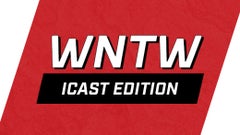Allen Boyd's Pattern, Baits & Gear
"Typically on those lakes in Kentucky where I have some experience, I knew if I was going to catch bigger largemouth, I had to find flatter pockets," he said. By flatter, he meant pockets that weren't so vertical. There was still deep water in the middle of them, but he needed some shallow water, especially toward the back. He used a contour shading feature on his Lowrance electronics to identify pockets that met his criteria. "For the flatter pockets, I had the shaded highlights set at 6 feet and when I saw pockets with blue in the back, I knew those weren't the bluffy pockets," he said. "One other thing that made them good was the pockets had nice guts in them. "Cumberland was low for a while and when the water was low, those guts get washed out deeper. They're real defined with the flat next to them. It's so simple for those fish to get in that gut if the water's falling or if a cold front shows up. They can move out to the gut and suspend. When it comes to time to spawn, it's easy for them to get on the flats or the edge next to the gut." While hundreds of pockets on the lake fit what he was looking for, he narrowed his focus to about 10 of them. The other key was the presence of baitfish. "I drove around and looked for ones loaded with bait - I could get bit in those, so I ran with that pattern," he added.
Rather than run around, he decided to pick an area and be more efficient. He settled on a creek down the lake as the fish continued to funnel into those pockets each day. "You could make a pass and not get a bite and 45 minutes later come back and catch a big one," he said. "They were coming in there big time and probably still are." Ultimately, he had a 1-2 punch of a spinnerbait and swimjig going around the flooded pockets. "It fits my style of fishing - staying shallow and picking them apart," he said. "The water in the area I fished was just beautiful. You couldn't ask for better."
Gear:
Spinnerbait gear: 6'9" medium-heavy G. Loomis spinnerbait rod, Shimano Curado K 200 casting reel (6.4:1 ratio), 15-pound Berkley Trilene Big Game monofilament, 1/2-oz. BOOYAH spinnerbait (white/chartreuse with chartreuse rear blade and white front blade).
Boyd started the week with four of the 1/2-oz. BOOYAH spinnerbaits, but he caught so many fish over the course of practice and the tournament that by the end of day 3, three had given out. He approached fellow angler Bradley Hallman at the weigh-in to see if he had any of the same model. Hallman retrieved his spinnerbait box from his truck and allowed Boyd to sift through it. "He didn't have the exact one, but the guy at Burnside Bait and Tackle (across from the hotel) was able to get me some blades," Boyd said. "They helped me get back in the game. I had to make due with what I had at the time."
He said the best blade combo was a #4 chartreuse willow blade along with a #2 white willow blade. "I thought I could catch them on a spinnerbait with all white blades, but when you catch that many on something it's hard to show up with something different," he added.
The spinnerbait rod Boyd favors is an out-of-production model by G. Loomis. "It's so light and sensitive that if I pick up a different rod to fish a spinnerbait with, I'm all over the grid," he said. "I can't be as accurate with it."
Swim jig gear: 7'6" heavy-action Lew's casting rod, same reel, 18-pound Sunline Shooter fluorocarbon line, 3/8-oz. Dirty Jigs No-Jack swim jig (Guntersville shad), Strike King Rage Craw trailer (white).
He dipped the pinchers of the trailer in chartreuse dye.
He mixed in the swim jig each day, especially in areas where he couldn't fish a spinnerbait cleanly. "There were places where if I got a big bite on a spinnerbait, I'd have a hard time getting it out," he said. "I threw it when I'd get around heavier cover and it got some key bites for me."
He said he usually fishes a 7-foot medium-heavy rod with a swim jig, but had to trade up for a more powerful rod based on the cover he was fishing. "For that application, I needed a heavier swim jig with a heavier weed guard and the Dirty Jig was perfect. I could cast it in bushes and trees and not get hung up. I had to use that heavier rod to get a hookset in them."
Main factor in his success: "Slowing down. With all the pressure in those areas, I knew there were areas guys weren't taking the time to get to. Picking those spots apart and making good casts to those targets was key. Also, not going through with my original plan of running around the lake was important."
Performance edge: "My Lowrance units played a big role. They can be a huge factor in finding shallow fish even when you're not graphing them. You're able to see stuff you're looking for on the map. When you're able to go around and find the bait - it was cool enough in practice so the bait wasn't showing itself - in 10 feet all over the lake, those units were key. That was the magic number all over the lake. Also, my Ranger was key in making those long runs and dodging the driftwood. It got rough at times and that L model performs incredibly well."
FLW Tour Lake Cumberland 2-5 Patterns BassFan 4/18/18 (Todd Ceisner)












